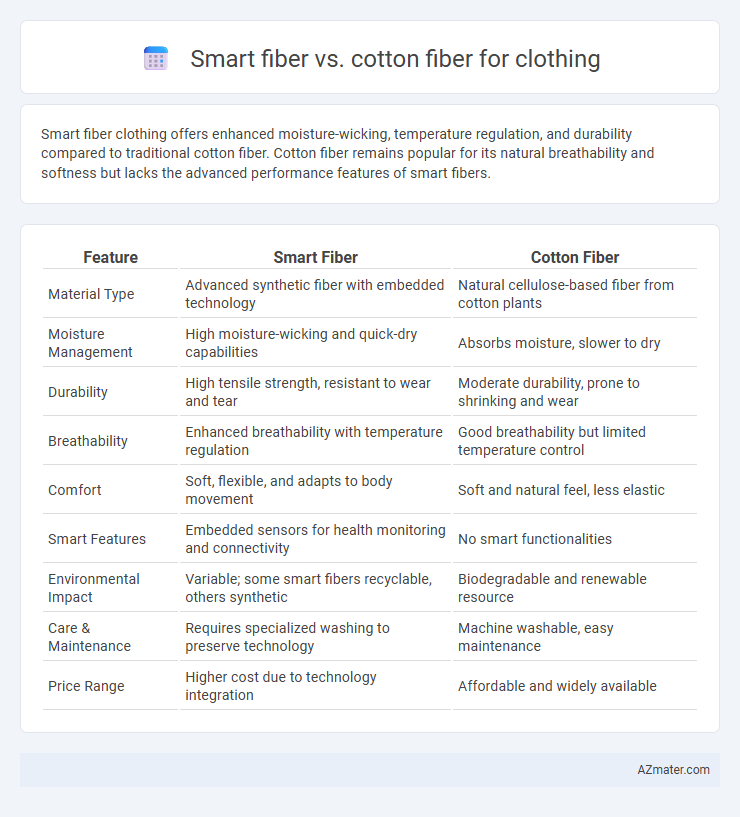Smart fiber clothing offers enhanced moisture-wicking, temperature regulation, and durability compared to traditional cotton fiber. Cotton fiber remains popular for its natural breathability and softness but lacks the advanced performance features of smart fibers.
Table of Comparison
| Feature | Smart Fiber | Cotton Fiber |
|---|---|---|
| Material Type | Advanced synthetic fiber with embedded technology | Natural cellulose-based fiber from cotton plants |
| Moisture Management | High moisture-wicking and quick-dry capabilities | Absorbs moisture, slower to dry |
| Durability | High tensile strength, resistant to wear and tear | Moderate durability, prone to shrinking and wear |
| Breathability | Enhanced breathability with temperature regulation | Good breathability but limited temperature control |
| Comfort | Soft, flexible, and adapts to body movement | Soft and natural feel, less elastic |
| Smart Features | Embedded sensors for health monitoring and connectivity | No smart functionalities |
| Environmental Impact | Variable; some smart fibers recyclable, others synthetic | Biodegradable and renewable resource |
| Care & Maintenance | Requires specialized washing to preserve technology | Machine washable, easy maintenance |
| Price Range | Higher cost due to technology integration | Affordable and widely available |
Introduction to Smart Fiber and Cotton Fiber
Smart fiber integrates advanced materials like conductive polymers and nanotechnology to enhance clothing functionality, offering features such as moisture-wicking, temperature regulation, and built-in sensors. Cotton fiber, a natural cellulose fiber derived from the cotton plant, is renowned for its breathability, softness, and hypoallergenic properties, making it a staple in traditional apparel. Comparing smart fiber's high-tech capabilities with cotton's natural comfort highlights the evolving landscape of textile innovation in the clothing industry.
Key Differences Between Smart Fiber and Cotton Fiber
Smart fibers incorporate advanced materials like phase change polymers or conductive threads, offering features such as temperature regulation, moisture sensing, and enhanced durability, unlike traditional cotton fibers which are primarily natural, breathable, and biodegradable but lack functional technology. Cotton fibers excel in softness, comfort, and hypoallergenic properties, making them ideal for everyday wear, while smart fibers prioritize performance and adaptability in specialized or activewear applications. The key differences lie in composition, functionality, and end-use, with smart fibers integrating technology to respond dynamically to environmental conditions, contrasting with cotton's static natural properties.
Comfort and Breathability: Which is Better?
Smart fibers, engineered with advanced moisture-wicking and temperature-regulating technologies, offer superior comfort and breathability compared to traditional cotton fibers. Cotton, renowned for its natural softness and breathability, excels in moisture absorption but can retain sweat, leading to discomfort in high-activity or humid conditions. Smart fibers optimize airflow and dryness, making them better suited for performance wear and environments demanding enhanced comfort and breathability.
Moisture Management and Sweat Absorption
Smart fibers outperform cotton fibers in moisture management by actively wicking sweat away from the skin, promoting faster evaporation and keeping the wearer dry and comfortable. Cotton fibers absorb moisture but tend to retain it, resulting in slower drying times and a damp, heavy feel during intense physical activity. Advanced technology in smart fibers, such as bio-based coatings and engineered microstructures, enhances breathability and sweat absorption while maintaining lightweight durability.
Durability and Longevity of Clothing
Smart fibers, engineered with advanced materials such as carbon nanotubes or phase-change compounds, offer superior durability and resistance to wear compared to traditional cotton fibers. Cotton fibers, while breathable and natural, tend to degrade faster due to moisture retention and repeated washing, leading to reduced fabric strength over time. The enhanced structural integrity of smart fibers ensures longer-lasting clothing, maintaining shape and function through extensive use and environmental exposure.
Environmental Impact and Sustainability
Smart fibers, often made from bio-based or recycled materials, offer significant environmental benefits by reducing water consumption, chemical use, and carbon emissions compared to conventional cotton fiber. Cotton cultivation requires extensive water resources and pesticides, contributing to soil degradation and biodiversity loss, whereas sustainable smart fibers are engineered for biodegradability and lower ecological footprints. Innovations in smart fiber technology promote circular fashion, enhancing durability and recyclability, which mitigates textile waste and supports a more sustainable clothing industry.
Innovation and Technological Advancements
Smart fibers incorporate cutting-edge nanotechnology and conductive materials to provide enhanced functionalities such as moisture-wicking, temperature regulation, and responsiveness to environmental stimuli, surpassing the limitations of traditional cotton fibers. Innovations in smart fibers include embedded sensors and self-cleaning properties, enabling real-time health monitoring and maintenance-free apparel. Unlike cotton, which offers natural comfort and breathability, smart fibers revolutionize clothing by merging textile science with digital technology for adaptive, performance-driven garments.
Cost Comparison and Affordability
Smart fibers typically have a higher initial cost than cotton fibers due to advanced materials and manufacturing technologies. Cotton fibers offer affordability and widespread availability, making them a cost-effective choice for large-scale clothing production. Long-term, smart fibers can reduce expenses through durability and performance benefits, but upfront costs remain higher compared to traditional cotton.
Applications in Modern Fashion and Sportswear
Smart fibers in modern fashion and sportswear offer advanced functionalities such as moisture-wicking, temperature regulation, and enhanced durability, making them ideal for activewear and performance garments. Cotton fibers remain valued for their breathability, softness, and natural comfort, often used in casual and everyday clothing. Combining smart fibers with cotton blends results in fabric that delivers both comfort and high-tech performance, meeting the demands of innovative fashion and athletic apparel.
Choosing the Right Fiber for Your Needs
Smart fibers offer advanced moisture-wicking, temperature regulation, and antimicrobial properties, making them ideal for activewear and performance clothing. Cotton fibers provide natural breathability, softness, and durability, suited for everyday comfort and casual wear. Selecting the right fiber depends on your lifestyle requirements: prioritize smart fibers for enhanced functionality or choose cotton for natural comfort and ease of care.

Infographic: Smart fiber vs Cotton fiber for Clothing
 azmater.com
azmater.com